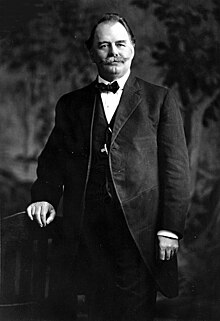William Sherman Jennings
| William Sherman Jennings | |
|---|---|
 |
|
| 18th Governor of Florida | |
|
In office January 8, 1901 – January 3, 1905 |
|
| Preceded by | William D. Bloxham |
| Succeeded by | Napoleon B. Broward |
| Member of the Florida House of Representatives | |
|
In office 1893 |
|
| Personal details | |
| Born | March 24, 1863 Walnut Hill, Illinois |
| Died | February 27, 1920 (aged 56) St. Augustine, Florida |
| Political party | Democratic |
| Spouse(s) | May Austin Mann Jennings |
William Sherman Jennings (March 24, 1863 – February 27, 1920) was an American politician. He served as the 18th Governor of Florida after being a lawyer, county judge, and state representative.
He was born near Walnut Hill, Illinois, and attended public schools in Marion County. Jennings graduated from Southern Illinois University in 1883, then studied law at the Union College of Law in Chicago (now named Northwestern University School of Law). and finished his law studies in Chicago under the supervision of his brother, Charles E. Jennings, who was the State's Attorney for Marion County.
He came to Florida in 1885 and settled in Brooksville, Florida. In 1887, he was appointed circuit court commissioner, and became county judge of Hernando County, Florida in 1888.
Jennings resigned his office as county judge in 1893 to serve in the Florida House of Representatives, eventually becoming Speaker of the Florida House of Representatives in 1895. After his term ended, he served as a Colonel in the Florida militia, was president of the Brooksville town council and chairman of the Democratic committee. Jennings campaigned for and was elected governor in 1900, taking the oath of office on January 8, 1901. During his term in office, he introduced the statewide primary election system, replacing the previous method of nominating candidates for political office at a convention. The first statewide primary election was conducted in 1902. It was also Jennings idea to drain and develop the Everglades by cutting the natural rock dams in the rivers of south Florida. His term ended on January 3, 1905.
He moved to Jacksonville, then Florida’s largest city, where he established a successful law practice. He divided his time between a home in Jacksonville and a farm and timber holdings in Clay County near Middleburg.
...
Wikipedia
